[IFA 2022] Panasonic OLED TV
#ifa2022 #panasonic #oledtv

https://ubiresearch.com/en/

https://en.olednet.com/

marketing@ubiresearch.com
+82-2-577-4391
#ifa2022 #panasonic #oledtv

https://ubiresearch.com/en/

https://en.olednet.com/

marketing@ubiresearch.com
+82-2-577-4391
By Hana Oh (hanaoh@ubiresearch.com)
The number of OLED TVs exhibited at CES 2018 increased to 31, which was a significant increase of 17 from CES 2017. The number of OLED TV companies that exhibited at CES 2018 were 7 including LG Electronics, Sony, Panasonic and Skyworth.
At CES 2018, OLED TVs were exhibited with 6 for 55-inch, 19 for 65-inch, and 6 for 77-inch. 65-inch OLED TVs were most on display, and it was noticeable that many companies were focusing on 65-inch OLED TV products. 77-inch OLED TVs in 6 types same as 55-inch were exhibited so that it was found to be included in the main lineup.
In addition, the display resolution of all OLED TVs was UHD because UHD products were mainly displayed according to consumers’ demand for high-definition TV. OLED TVs with FHD resolution had been exhibited until 2015, and only OLED TVs with UHD resolution have been on display since 2016.
Meanwhile, LG Display’s Vice Chairman Han Sang-beom said, “We will raise the sales portion of OLEDs to 40% of total sales by 2020” in a press conference on 8th local time, which implied that OLED TV market will be more expanded.
In addition, Vice Chairman Han Sang-beom said that two major Chinese companies will join the OLED market. As a result, the number of OLED manufacturers will grow from 13 to 15, including LG Electronics, Sony and Panasonic so that the OLED companies are expected to be expanded further.
OLED TV, which is currently leading the premium TV market, is expected to see a bigger rise.
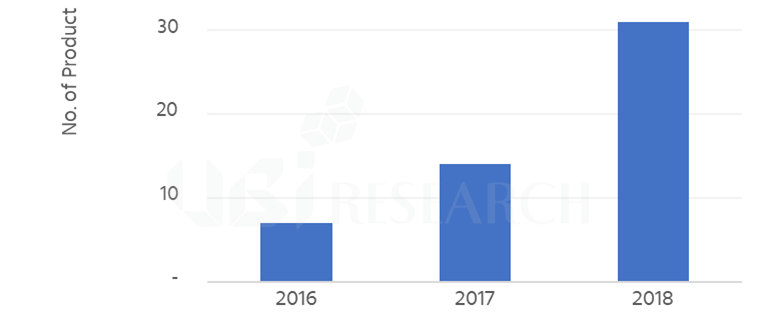
OLED TV models launched in 2017 have been highly increased rather than both 2015 and 2016. 16 types of OLED TVs were launched in 2016, while 29 kinds of OLED TVs were launched which covers that the number of products has nearly doubled from last year. By company, LG Electronics released total 10 types of products which are the greater number of products launched than competitors, and followed by Loewe with 5 types of products.
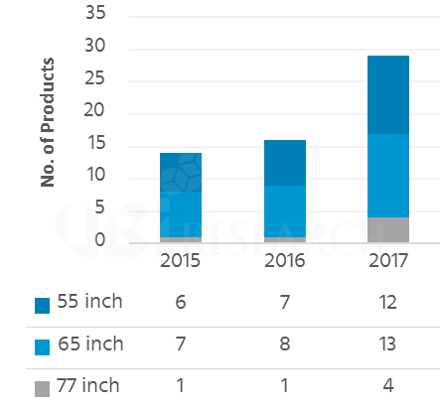
<Comparison of No. of OLED TVs by each year>
Meanwhile, OLED TV market led by LG Electronics, was taken attentions of publics when Sony decided to launch OLED TV first in the early of 2017. Sony which launched OLED TV first in CES 2017 to catch public’s eyes with “Acoustic Surface” technology that can make sounds without speakers, is leading the premium market with LG Electronics by producing 55-inch, 65-inch and 75-inch OLED TVs.
The number of OLED TV products are expected to increase in 2018 more and more. According to Flat Panels HD, Philips which launched only one model with 55-inch OLED in the early of this year, decided for releasing the 6 kinds of OLED TV such as 65OLED973, 65OLED903, 65OLED873, 65OLED803, 55OLED903, 55OLED803 and so forth. It is analyzed that the strategy is to aim at diverse consumers which divides OLED TV leading the premium TV market into high-priced line with 9xx model and low-priced line with 8xx model.
The shipment in 2018 is also expected to grow. In accordance with UBI Research, it expects that OLED panel with 55-inch and more will shipped over 2.4 million units in 2018, 9.1 million units in 2022. There is much attentions how OLED TV leading premium TV market will harden its positions all the more in 2018.
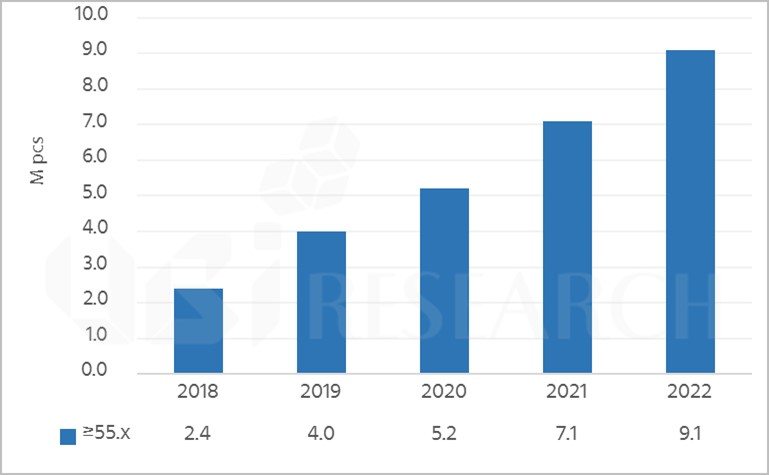
<Shipment forecasting of OLED panel in 55-inch and more in 2018-2022>
LG Electronics announced on last 11th that LG OLED TV is speeding up the popularization with the monthly sales volume of 10,000 units and above for the first time in Korea. In addition, Sony, which joins the OLED TV camp in 2017, is enjoying great popularity and continues to expand its market share in the premium TV market. As such, OLED TV is leading the premium TV market by improving cost competitiveness through cost reduction as well as excellent image quality.
OLED TVs are currently being mass-produced by LG Electronics, Sony, Toshiba and Panasonic. Although all set makers that produce OLED TVs use OLED of LG Display, they are producing OLED TVs with different characteristics and advantages.
First, LG Electronics mentioned OLED’s vivid image quality and wall paper design as advantages of OLED W7 which is a signature TV. LG Electronics mentioned that OLED, which is a self-luminous element, can express near-infinite contrast ratio and rich color close to nature, and supports Dolby vision HDR and HDR10 to experience vivid image quality. Also, introduced that a 4.6mm of thin panel provided the experience of seeing the theater screen and all parts except the panel were housed in a space called innovation stage and completed the perfect wall paper design.
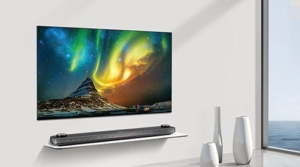
<OLED TV W7 of LG Electronics, Source: LG Electronics>
Sony emphasizes sound, image quality and simple design as the advantage of 4K BRAVIA OLED TV A1E series. It mentioned that the TV screen, which attracted great attention in last year’s CES 2017, can provide an enhanced immersive feeling by applying the ‘Acoustic Surface’ that the TV screen vibrates and makes sound by itself. In addition, the ‘X1 extreme processor’ HDR chip has been applied to improve the picture quality of OLED TV, and the cable is housed in the stand on the backside so that the simple design is realized.
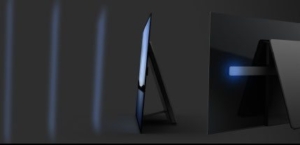
<Acoustic Surface of Sony 4K BRAVIA OLED TV A1E, Source: Sony>
Toshiba then mentioned a high color gamut of 100% DCI-P3 and a high brightness of over 800 nits as the advantages of the REGZA X910. It said that it increased the color reproduction rate to express natural colors and improved the brightness to express the bright and dark parts in richer gradations and strengthened HDR restoration function to realize sharp and realistic high-definition video.
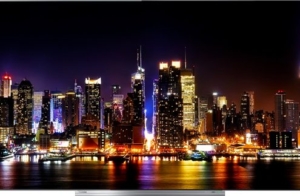
<REGZA X910 of Toshiba, Source: Toshiba>
Lastly, Panasonic stated that it implemented full black and rich color expressions. Especially, it emphasized that it applied ‘Hexa chroma drive plus’ which is Panasonic’s high-definition technology to express high contrast and colors hidden in dark areas that were difficult to implement in LCD TV and reproduced the emotion that the video producer intended.

<Comparison of ‘Hexa chroma drive plus’ technology application of Panasonic, Source: Panasonic>
As such, OLED TV set makers are introducing different OLED TVs that emphasize their characteristics and advantages. In addition to the above four makers, LOEWE of Germany and B & O of Denmark are expected to continue to launch OLED TVs, including mass production of OLED TVs or preparations for mass production. Based on the unique technology of set makers, it is worth noting that OLED TVs with what kind of characteristics and advantages will be produced.
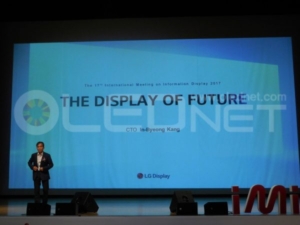
LG Display is expanding in earnest in OLED market.
In the keynote session of IMID 2017 held in Busan on 29th, LG Display’s CTO Kang In-byeong pointed out the future plan of LG Display as “OLED is a strong candidate to lead the future display industry”.
Kang In-byeong, CTO, said that by 2020, large-area OLED will increase its production capacity by 7 times to 2020, thereby reducing the cost cap with LCD and leading the market on the basis of technology such as wall paper, sound integration, rollable and transparent flexible. LG Display recently invested in Gen8.5 in China and is expected to invest in Gen10.5 OLED mass production line at Paju P10 plant.
On the other hand, for small and medium-sized OLEDs, they have announced that they will use a fast follower strategy based on plastic OLED. LG Display is in mass production of plastic OLED panel to be applied for LG Display’s next smartphone, V30, next smartphone, and is ready for the mass production in the E5 line of Gumi. In addition, they plan to invest 10trn won additionally to Gen6 line, which is expected to increase 13 times the current capacity by 2020.
Based on this aggressive OLED investment, LG Display plans to raise its portion of OLED sales up to 40% in 2020 from current 5% in large-area OLEDs and small- and medium-sized OLEDs.
Currently, large-area OLEDs continue to increase capacity and yield and LG Display is likely to expand sales in the future, as it is dominating the premium TV market as it is expanding the camps of Sony, Philips and Panasonic as well as LG Electronics. The success of mass production in small- and mid-sized OLEDs will determine whether or not LG Display plans to achieve its plan.
JOLED announced on last 17th that it developed the world’s first 21.6 inch 4K OLED panel with RGB inkjet printing process and shipped the prototype from April.
Developed by JOLED’s RGB inkjet printing process, the thickness of the panel is 1.3mm, weighs 500g, brightness is 350cd/m2, and contrast ratio is 1,000,000: 1. According to JOLED, this panel was applied to medical monitors.

<21.6 inch OLED and its specifications developed by JOLED, source: JOLED>
JOLED said ‘Ink-jet printing is a technology for printing by applying a light emitting material, which the production process is simple and easy to expand to diverse screen size, so it has been put into practical use. The top emission, viewing angle and color reproducibility of OLED panels will be improved.’
In addition, JOLED has announced its plans for the future ‘to expand its inkjet printing-type small and medium-sized OLED applications (such as gaming monitors, automotive applications, etc.) or suppliers continuously.’
JOLED is a company established by INCJ, JDI, Sony and Panasonic, and is actively developing inkjet printing process. Among the panel makers, JOLED is the only company that has released a product developed by inkjet printing process in 2016.
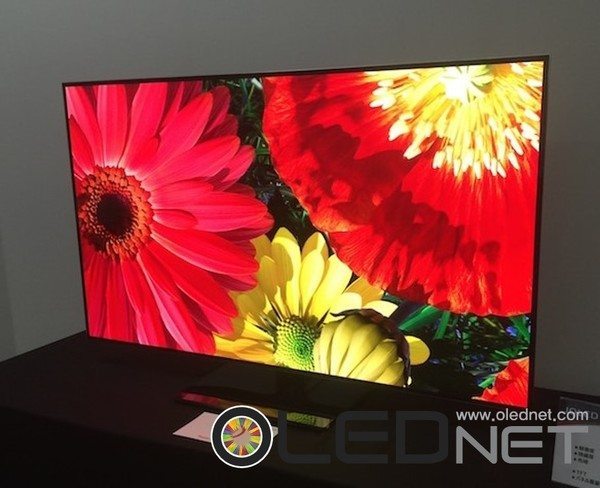
<55inch 4K flexible AMOLED panel unveiled by JOLED in 2016>
According to Ubi research’s ‘ Market Entry Analysis for Solution Process OLED -The Possibilities and Opportunities‘, ink-jet printing is one of the process methods of the solution process, in which the ink-jet head is used to drop ink onto each pixel. Major panel makers are developing a solution process using this process, and JOLED is expected to take a lead in the future.
The solution process is capable of realizing large-area OLED panel with RGB pixel structure in Gen8 and above, has high material utilization efficiency, and is developed as a simple layer, which is advantageous in cost reduction in mass production success.
Meanwhile, Lee Choong-hoon, CEO of UBI Research, said, “Although the large-area OLED market is targeting the premium market with the WRGB method, the solution process will be the core technology since low-cost and high-production technology is key to replacing LCDs with OLEDs.”
On 16th, Consumer Reports, an American consumer magazine rated LG Signature TV W 89 scores in the TV quality category. It was an all-time high, overtaking LG OLED TV(OLED65C7P) that ranked number 1 with 88 scores in the ‘4K TV(Best 4K TVs to Buy Right Now)’ category in April.
LG Signature TV W features not only the thinnest display(4mm including a wall-mounted TV stand) by applying OLED panel and specially-designed finishing materials, but also the greatest immersion by eliminating unnecessary factors. Due to that reason, LG Signature TV W won ‘Best of the Best’ and ‘Best TV Product’ awards at CES 2017 and was once acclaimed as ‘a beautiful TV like a work of art’ from Engadget.
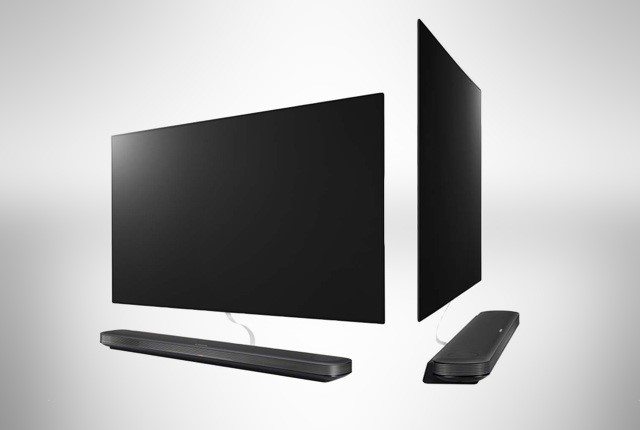
<LG Signature TV W, Source : mybroadband>
Meanwhile, LG Ultra OLED TV and Sony OLED TV came in second. Among the 11 TV models from top 1 to 10 selected from Consumer Reports, 10 out of 11 were OLED panel-based TVs, whereas a LCD-based TV was only Sony’s BRAVIA.
OLED TV is receiving lots of attention of consumers due to its great picture. In last March, Director Yoon Soo-young of LG Display said at the 3rd OLED Korea Conference hosted by UBI Research that “OLED TV on display has been moved from the corner to the center of the Best Buy LG store”, and OLED TV is becoming the mainstream of the premium TV market. Accordingly, many second movers are joining the trend of OLED TV and have released OLED TVs or announced a plan to release.
Toshiba launched 55 and 65-inch OLED TV Regza last march, and German luxury AV brand Loewe lunched its new flagship Bild 9 series, 55 and 65-inch 4K OLED TV on May 1, beginning to release OLED TVs in the premium TV market in earnest.
In addition, Sony, which attracted big attention for its OLED TV unveiled for the first time at CES 2017, officially announced on May 8th that they will firstly sell 55 and 65-inch sizes of 4K BRAVIA OLED TV A1E series. Panasonic also announced on May 14th that they will firstly sell EZ900, 950, and 1000 among 4K OLED TV in Japan from June.
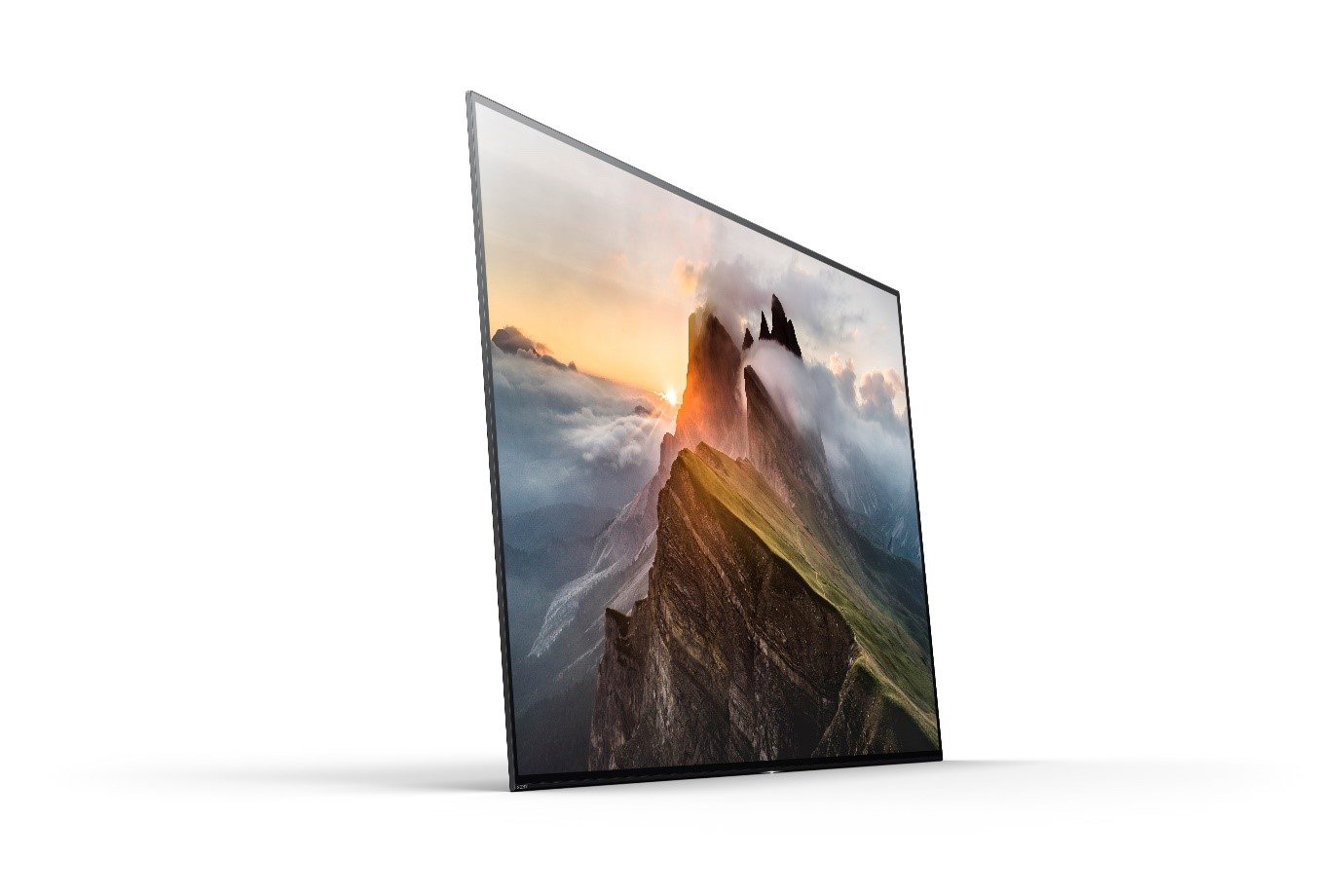
<Sony’s 4K BRAVIA OLED TV A1E, Source : Sony blog>
Meanwhile, Choong Hoon Yi, president of UBI Research(senior analyst) analyzed at the Topic seminar in April that Sony’s OLED TV is expected to sell about 400,000 in 2017. Accordingly, he expected Sony’s OLED TV will have about 27% market share in the OLED TV market and about 38% in 2021.
Choong Hoon Yi, Chief Analyst, UBI Research
BOE is intending to carry out a large amount of investment in order to operate Gen10.5 LCD line from 2018. Meanwhile, key set makers including Apple, Samsung Electronics, LG Electronics, and Panasonic are devising strategy to move from LCD to OLED for smartphone and premium TV displays. As such, it is becoming more likely for the LCD industry to be in slump from 2018.
At present, the area where LCD industry can create profit is LTPS-LCD for smartphone. The forecast smartphone market for this year is approximately 15 billion units. Of this, Samsung Electronics and Apple are occupying 20% and 15% of the market respectively. OLED equipped units are less than 2 billion.
However, from 2018 the conditions change greatly. Firstly, Apple, which has been using LCD panel only, is estimated to change approximately 40% of the display to OLED from 2017 earliest and 2018 latest. Apple is testing flexible OLED panels of JDI, LG Display, and Samsung Display, and recommending them to invest so flexible OLED can be applied to iPhone from 2017. The total capa. Is 60K at Gen6. As new investments for Gen6 line of Samsung Display and LG Display are expected to be carried out from 2016, supply is theoretically possible from 2017.
If 5inch flexible OLED is produced from Gen6 line, under the assumption of 50% yield at 60K capa. 65 million units can be produced annually, and approximately 1 billion units if the yield is 80%. If Apple’s iPhone shipment in 2017 is estimated to be around 2.7 billion units, within the 50-60% yield range approximately 25% of the display is changed to OLED from LCD, and if yield reaches 80% around 40% will change. The companies that are supplying Apple with LCD for smartphone, LG Display, JDI, and Sharp, are expected to show considerable fall in sales and business. These 3 companies could be reduced to deficit financial structure just from Apple’s display change
Furthermore, as Apple is not producing low-priced phones, under the assumption that future iPhone could all have OLED display, Apple could cause the mobile device LCD industry to stumble after 3 years.
Samsung Electronics also is gradually changing Galaxy series display to OLED from LCD. Of the forecast 2015 shipment of 3 billion units, 50%, 1.5 billion units, has OLED display, but Samsung Electronics is expected to increase flexible OLED and rigid OLED equipped products in future. Particularly, as Apple is pushing for flexible OLED application from 2017, Samsung Electronics, whose utilizing OLED as the main force, is estimated to increase flexible OLED usage more than Apple. It is estimated that all Galaxy series product displays will be changed to OLED from 2019.

Under these assumptions, of the estimated smartphone market in 2020 of approximately 20 billion units, Samsung Electronics and Apple’s forecast markets’ 7 billion could be considered to use OLED.
Samsung Display is strengthening supply chain of set companies using their OLED panels. Samsung Display is supplying OLED panels to diverse companies such as Motorola and Huawei as well as Samsung Electronics, and also expected to supply rapidly rising Xiaomi from 2016. If smartphone display is swiftly changed to OLED from LCD from 2017, Chinese display companies that are currently expanding TFT-LCD lines are to be adversely affected.
Additionally, in the premium TV market, LG Electronics mentioned that they will focus on OLED TV industry at this year’s IFA2015. As a part of this, LG Display is planning to expand the current Gen8 34K to 60K by the end of next year. Furthermore, in order to respond to the 65inch market, Gen9.5 line investment is in consideration. In the early 2015, Panasonic commented that they were to withdraw from TV business but changed strategy with new plans of placing OLED TV on the market in Japan and Europe from next year.
As Samsung can no longer be disconnected from the OLED TV business, there are reports of investment for Gen8 OLED for TV line in 2016. Although OLED TV market is estimated to be approximately 350 thousand units this year, in 2016, when Panasonic joins in, it is expected to expand to 1.2 million units. The OLED TV’s market share in ≥55inch TV market is estimated to be only 4% but in premium TV market it is estimated to be significant value of ≥10%.

If Samsung Display invests in Gen8 OLED for TV line in 2016, from H2 2017 supply to Samsung Electronics is possible. As OLED Gen8 line’s minimum investment has to be over 60K to break even, it can be estimated that Samsung Display will invest at least 60K continuously in future.
Under these conditions, LCD industry can only be in crisis. Firstly, it becomes difficult for Sharp to last. Sharp, which is supplying TFT-LCD for Apple’s iPhones and LCD for Samsung Electronics’ TV, will lose key customers. Secondly, BOE, AUO, and JDI, the companies selling LCD panels to these companies, are not ready to produce OLED and therefore damage is inevitable.
BOE is carrying out aggressive investment with plans to lead the display industry in future with operation of Gen10.5 LCD line. Therefore, from 2018, as the main cash cow items disappear, administration pressure could increase.
Dr Choong Hoon Yi, UBI Research Chief Analyst, ubiyi@ubiresearch.co.kr
Korean TV industry, according to recent reports by media, is showing a red light not being able to escape the deficit structure.
Samsung Electronics and LG Electronics possess high market share in costly premium TV market. However, in 30inch grade market, the two companies struggle against economically priced sets. In order to maintain sales, Samsung Elec. and LG Elec. are managing diverse product portfolio but business profit keep falling. Due to this, LCD panel stocks produced by Samsung Display and LG Display are steadily increasing.
LCD panel business is sinking into a pit.
What is the reason that Korea’s LCD TV and LCD business values can only become worse?
This can be forecast from looking at Japan’s TV and LCD business. Until the early 2000s, Japan was one of the leaders in electronics. However, Japan’s TV business is gradually dying out. Japan’s leading companies, Sony and Panasonic’s TV business began to be deteriorate because of Korean mid-low price products. In succession, Sony ended up spinning off the TV business, and Panasonic stopped TV business other than for domestic supply. Korean TV companies began to dominate the market. However, only a few years since then, Korean TV industry is losing commercial value, pushed aside by mid-low price products manufactured by China and others.
Second is display investment. As Japanese TV industry began to crumble, Japanese display companies had no choice but to stop the investment. The companies could not see a way to make profit through investment even if TV market grew as client companies’ panel purchasing power fell. Korea is the same. Samsung Elec. and LG Elec.’s TV business profitability deterioration led toward Samsung Display and LG Display’s halting the investment. On the other hand, Chinse display companies began Gen10.5 line investment. TV industry relies on assembly business and business network and therefore initial investment cost is low. In comparison, display industry is high risk as it requires large scale investment from early stages. If the business profit falls without investment cost return, companies face great loss and business closure is also not easy.
The third reason that Japanese TV companies are dying out is because they could not produce premium TV. Sony, which lost its competitiveness in LCD TV, tried to strengthen its market leadership through 4K TV. However, the brand value was already down and with the lack of marketing value, Sony easily gave up the market to companies in pursuit such as Samsung Elec. and LG Elec. LCD TV already had no difference in quality whether it was produced by a Korean or Japanese company, and brand value order had switched. LCD TV quality produced by Chinese companies is already reached the top. They are no longer companies who produce cheaper knockoffs. Furthermore, LCD panel production technology of Korea, Japan, Taiwan, and China can now be deemed equal.
The final reason that stops Japanese TV business from securing market is that they failed to suggest differentiation point in premium TV. Fundamentally, differentiation is not possible for LCD TV. The biggest differentiation factors in the current TV market are picture quality and design. Any company can produce thin LCD TV and curved LCD TV. Panel size, resolution, and QD-LED using color gamut that LCD can actualize can no longer be differentiated technology. The difference of LCD panel and TV manufacturing technology between Korea, Japan, Taiwan, and China is already within a year. No matter what kind of product is released, market control has one year of expiration period. Considering the promotion period required in the market is approximately 6 months, the period where profit can be made is shortened even further.
So what is the solution for the Korean TV industry to survive?
As I have mentioned dozens of times for several years, what is left is OLED TV. What LCD cannot do in terms of picture quality and design, with OLED it is possible. Therefore, only the non-LCD products can enjoy the key factors of differentiation in premium TV market.
Existing premium TV is IPTV, a market that Japanese TV companies have been pursuing since early 2000s. Internet connection is possible through TV and allows for exchange of information in both directions. The basic concept of IPTV is watching TV while searching the information on TV via internet. But how useful is this concept at present? The usefulness of IPTV is becoming increasingly low as smartphone is used to search information, use the internet, and even watch TV. With no reason to use the internet via TV, TV companies should seriously consider whether TV with high white brightness is really needed. Rather than white TV with high brightness, it is time to place more importance in the functions of the TV itself. TV screen only uses 20-30% of full white brightness. Films, with outdoor shooting, falls under 20%, and for contents shot at night, black is more important.
Considering ‘blackness’ and design, anyone can find where the solution lies. If the foolish notion of trying to make OLED as bright as LCD is abandoned, there is hope.
UBI RESEARCH / CEO:Choong Hoon Yi / Business License Registration Number 220-87-44660
ADDRESS: A-1901, Samho Moolsan Bldg, 83, Nonhyeon-ro, Seocho-gu, Seoul, Republic of Korea (Zip) 06775 TEL:+82-2-577-4390 / E-MAIL:marketing@ubiresearch.com
